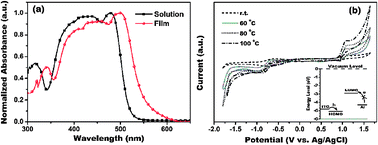Molecular length adjustment for organic azo-based nonvolatile ternary memory devices†
Abstract
Two conjugated small molecules with different molecular length, DPAPIT and DPAPPD, in which an

Maintenance work is planned for Wednesday 1st May 2024 from 9:00am to 11:00am (BST).
During this time, the performance of our website may be affected - searches may run slowly and some pages may be temporarily unavailable. If this happens, please try refreshing your web browser or try waiting two to three minutes before trying again.
We apologise for any inconvenience this might cause and thank you for your patience.
* Corresponding authors
a
Key Laboratory of Organic Synthesis of Jiangsu Province, College of Chemistry, Chemical Engineering and Materials Science, Soochow University, Suzhou, Jiangsu 215123, China
E-mail:
lujm@suda.edu.cn
Fax: +86 512 65880367
Tel: +86 512 65880368
b Institute of Chemical Power Sources, Soochow University, Suzhou, Jiangsu 215006, China
c School of Chemical and Biomedical Engineering, Nanyang Technological University, 70 Nanyang Drive, Singapore
d Institute for Clean Energy and Advanced Materials, Southwest University, Chongqing 400715, China
Two conjugated small molecules with different molecular length, DPAPIT and DPAPPD, in which an

 Please wait while we load your content...
Something went wrong. Try again?
Please wait while we load your content...
Something went wrong. Try again?
S. Miao, H. Li, Q. Xu, N. Li, J. Zheng, R. Sun, J. Lu and C. M. Li, J. Mater. Chem., 2012, 22, 16582 DOI: 10.1039/C2JM32992A
To request permission to reproduce material from this article, please go to the Copyright Clearance Center request page.
If you are an author contributing to an RSC publication, you do not need to request permission provided correct acknowledgement is given.
If you are the author of this article, you do not need to request permission to reproduce figures and diagrams provided correct acknowledgement is given. If you want to reproduce the whole article in a third-party publication (excluding your thesis/dissertation for which permission is not required) please go to the Copyright Clearance Center request page.
Read more about how to correctly acknowledge RSC content.
 Fetching data from CrossRef.
Fetching data from CrossRef.
This may take some time to load.
Loading related content
